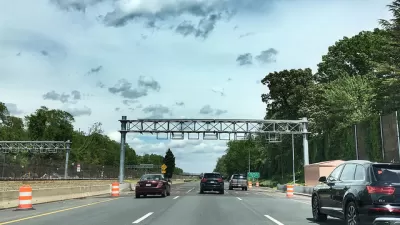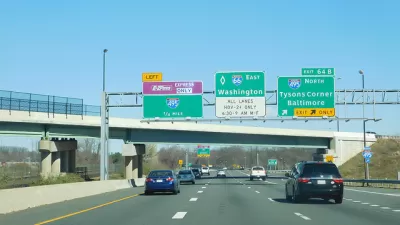The peak tolls achieved during the first week of operation of the new HOT lanes on I-66 in Virginia raised eyebrows this week. Here's a closer look at the data behind the new system.
Mike Grinnell takes a deep dive into the data behind the I-66 express lane system that went into operation this week, making headlines for charging $40 to access the new HOT lanes during the Tuesday morning peak period.
First, Grinnell makes clear the changes this week on I-66:
A few things changed for drivers with the introduction of these new HOT lanes, but the biggest change was for single-occupancy vehicle drivers. Previously they were restricted from driving on I-66 eastbound between 6:30 am and 9:00 am and westbound between 4:00 pm and 6:30 pm. Outside of these time restrictions, they were free to access the roads anytime.
Then, Grinnell compares the actual toll prices to the estimates prepared by the Virginia Department of Transportation two years ago when planning the HOT lane system. Despite the eye-popping figures picked up by news outlets around the country (including us), the numbers did hold pretty close to the original estimates.
By taking a closer look at the numbers, Grinnell is also able to pull a couple early lessons from the system, including when driving is most expensive and insight into how dynamic pricing works. Grinnell also reminds readers that the tolls will pay for the installation and upkeep of the tolling system in addition to multi-modal transportation improvements like bus service, park-n-ride facilities, improvements to Metro, and road improvements.
FULL STORY: After the outcry over the $40 tolls on I-66, this solo driver crunched the numbers

Study: Maui’s Plan to Convert Vacation Rentals to Long-Term Housing Could Cause Nearly $1 Billion Economic Loss
The plan would reduce visitor accommodation by 25,% resulting in 1,900 jobs lost.

North Texas Transit Leaders Tout Benefits of TOD for Growing Region
At a summit focused on transit-oriented development, policymakers discussed how North Texas’ expanded light rail system can serve as a tool for economic growth.

Why Should We Subsidize Public Transportation?
Many public transit agencies face financial stress due to rising costs, declining fare revenue, and declining subsidies. Transit advocates must provide a strong business case for increasing public transit funding.

How to Make US Trains Faster
Changes to boarding platforms and a switch to electric trains could improve U.S. passenger rail service without the added cost of high-speed rail.

Columbia’s Revitalized ‘Loop’ Is a Hub for Local Entrepreneurs
A focus on small businesses is helping a commercial corridor in Columbia, Missouri thrive.

Invasive Insect Threatens Minnesota’s Ash Forests
The Emerald Ash Borer is a rapidly spreading invasive pest threatening Minnesota’s ash trees, and homeowners are encouraged to plant diverse replacement species, avoid moving ash firewood, and monitor for signs of infestation.
Urban Design for Planners 1: Software Tools
This six-course series explores essential urban design concepts using open source software and equips planners with the tools they need to participate fully in the urban design process.
Planning for Universal Design
Learn the tools for implementing Universal Design in planning regulations.
City of Santa Clarita
Ascent Environmental
Institute for Housing and Urban Development Studies (IHS)
City of Grandview
Harvard GSD Executive Education
Toledo-Lucas County Plan Commissions
Salt Lake City
NYU Wagner Graduate School of Public Service




























